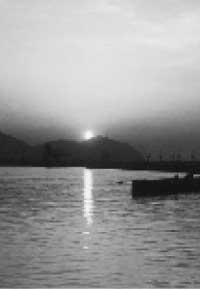Enjoying Physics (II)
Crazy photos
As we said in the January issue, we know that light rays spread linearly. Moreover, we saw a use of this property in the manufacture of cilia. Let us now see another use of this property, that is, “curious photos”.
The conventional photo-machine is just a dark camera with a hole basically. This circular hole is usually closed and inside, on the front wall of the attic, is the membrane or film to be recorded. Once the hole is opened, the rays of light penetrate the outside and record the image they carried when they hit the membrane. For this image to be better, photo-machines usually carry a lens (i.e. objective) in the hole, but in reality it is not mandatory.

A curious variety of non-target photo-machine belongs to the slot. Instead of having a circular hole, it has two plates and each has a slot. To see how it works, let's assume that one of these slots is vertical (sheet B) and the other horizontal (sheet C).
If the plates B and C overlap, the rays coming out of object D will find a small hole and on membrane A we will have a typical image. Conversely, if there is a distance between sheets B and C (as shown in the image), the image of object D will appear distorted on membrane A. Why?
The rays that protrude from the vertical lines of object D (which is a cross) will pass through slot C as if it were a circular hole and the groove of the second sheet will not hinder its trajectory. Therefore, what appears on membrane A will be the image of the vertical line of D, greater or lesser depending on the distance between C and A.
However, with the horizontal line of D the same will not occur. Its rays will pass through the C slot like the others, quietly and without distortions, as if it were a circular hole. But when plating against sheet B they find something like the circular hole again and what they give in membrane A will depend on the distance between A and B.
Therefore, in this case, for the vertical lines of the object in D it is as if we had a circular hole in sheet C and for the horizontal lines the hole would be in sheet B. Since the distance between A and C is greater than between A and B, the vertical dimensions that appear in membrane A are greater than the horizontal ones, that is, the image appears distorted, that is, lengthened vertically.
Of course, if the slot we have in C was vertical and that of horizontal B, the distortion would be reverse, i.e. increased horizontally. The image obtained with slits in any other position will have a new deformation. Therefore, we can get an unreal photograph and a cartoon or a curious image.

These types of photographic machines have their own practical applications, especially in the field of architecture and decoration.
Speed of light rays
As we all know, the light in its expansion moves at a speed of 300,000 km/s. Therefore, it will take time to get from any focus to our eyes. Therefore, we wonder if we see that in one place the Sun rises at six in the morning, at what time would we see that exit if the speed of light were infinite, that is, if they arrived as soon as the rays came out?
The distance between the Sun and Earth causes light to occupy eight minutes. Therefore, if the light came abruptly, we should see the sunrise eight minutes earlier, that is, the five and fifty-two o'clock. Do you agree?
Well, no. This result is totally wrong. If this happened, at six o’clock we would see the “sunrise” of the Sun. But how is it possible? Very easy. The “sunrise” of the Sun is not the sunrise, but the return of the Earth’s sphere and that “exit” is the entrance of the Earth to a previously illuminated space. Therefore, regardless of the speed of light, in this case we would always see the Sun at six o'clock.
Another thing is that observatories see an explosion or telescope on the surface of the Sun. So yes, the deadline between what was seen and what happened is eight minutes, but that was not our question.
Buletina
Bidali zure helbide elektronikoa eta jaso asteroko buletina zure sarrera-ontzian











